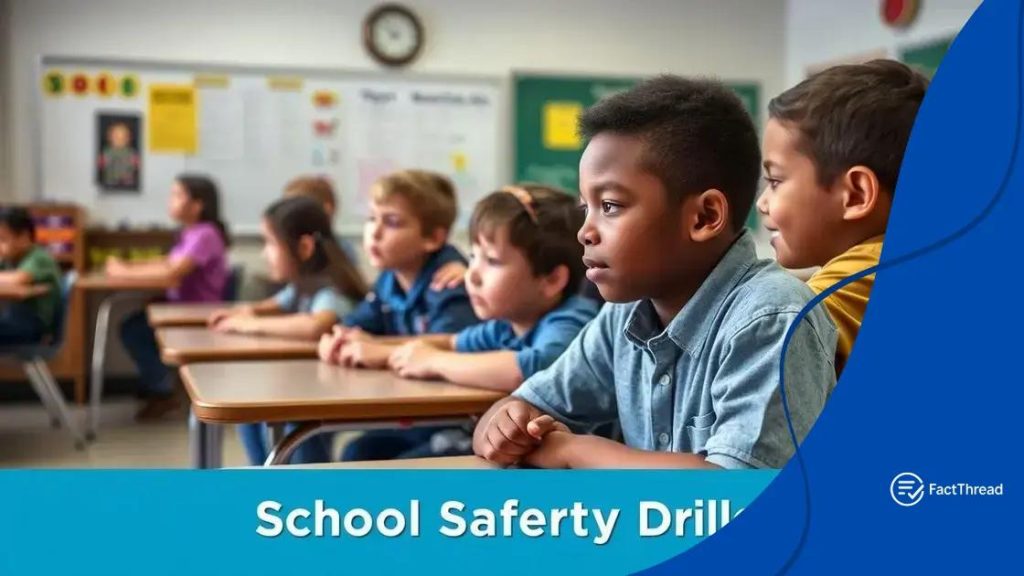School safety drills and protocols reviewed: are they effective?

School safety drills and protocols are vital for preparing students and staff for emergencies, ensuring they understand procedures and reducing panic during real crises.
School safety drills and protocols reviewed can spark essential conversations. How effective are these measures in protecting our students? Let’s explore the landscape of safety in schools today.
Understanding the importance of school safety drills
Understanding the importance of school safety drills is vital for every educational institution. These drills not only prepare students and staff for emergencies but also help create a culture of safety.
By practicing safety drills regularly, schools can ensure that everyone knows what to do in case of an emergency. This preparation increases confidence and reduces panic during real situations.
Why are safety drills necessary?
School safety drills are designed to handle various emergencies, from natural disasters to security threats. When students and staff practice these drills, they develop skills that may save lives.
Key benefits of safety drills:
- Increased awareness of emergency procedures
- Improved response times during actual emergencies
- Enhanced communication between staff and students
- Opportunities for feedback and improvements
Regular safety drills help build trust between students and their environment. When students feel safe, they are more likely to focus on learning. Schools that prioritize safety cultivate an environment where education can thrive.
Furthermore, safety drills foster teamwork and cooperation among students and staff. By participating in these exercises, everyone learns to depend on one another during crises, which strengthens school spirit.
In conclusion, understanding the importance of school safety drills can lead to a safer and more prepared educational experience. Schools that implement effective drills will not only protect their students but also empower them to act confidently in emergencies.
Types of safety drills commonly practiced
There are various types of safety drills commonly practiced in schools, each designed to prepare students and staff for different emergencies. Understanding these drills is essential for ensuring a safe learning environment.
One of the most recognized drills is the fire drill. During these drills, everyone practices evacuating the building quickly and safely. Students learn the best exit routes and how to stay calm.
Common types of safety drills:
- Fire drills: Essential for teaching evacuation procedures.
- Lockdown drills: These prepare everyone for potential threats within the school.
- Earthquake drills: Important for teaching students how to protect themselves during seismic events.
- Severe weather drills: These ensure that students know where to go during tornadoes or hurricanes.
These drills often complement one another, creating a comprehensive safety plan for schools. For example, after a fire drill, students may participate in a lockdown drill to understand how to respond to different types of emergencies.
Additionally, schools sometimes conduct drills for medical emergencies, such as knowing how to help a classmate who gets injured. These exercises instill confidence in students, making them feel prepared for unexpected situations.
In summary, practicing various types of safety drills builds a foundation of safety awareness in schools. When students understand these drills, they become more capable of handling emergencies effectively.
Evaluating the effectiveness of current protocols

Evaluating the effectiveness of current protocols is essential for ensuring the safety of students and staff during emergencies. By analyzing how well these protocols work, schools can make necessary adjustments to improve preparedness.
To evaluate these protocols, schools often conduct reviews and drills. Feedback from students and staff during these practices can provide valuable insights. For example, if students find it difficult to follow instructions, this could indicate a need for clearer guidelines.
Indicators of effectiveness:
- Response time: How quickly individuals can respond during an emergency drill.
- Comprehension: Whether students understand the safety procedures and steps to take.
- Communication: The clarity of messages delivered during drills and actual emergencies.
- Participation: The level of engagement from both students and staff during safety drills.
Evaluating response times is crucial. It helps determine how prepared everyone is to act when the situation demands it. If there are delays, schools need to revisit their protocols and make necessary improvements.
Another important factor is how well everyone understands the safety procedures. If students feel confused or unsure, the school should consider revising the training methods. Using simpler language or incorporating visual aids may help.
Effective communication during drills is also key. If students cannot hear instructions clearly, it might lead to chaos during a real emergency. Regular assessments ensure that messages are communicated effectively.
By measuring participation levels, schools can assess how engaged their communities are in practicing safety protocols. High participation usually reflects a strong awareness and commitment to safety within the school.
Best practices for improving safety drills
Implementing best practices for improving safety drills can significantly enhance the effectiveness of emergency preparedness in schools. These practices ensure that drills are not only completed but are also meaningful and engaging for everyone involved.
One important practice is to regularly review and update the drills. As new information becomes available, schools should adapt their protocols to reflect current safety standards. This not only helps keep everyone safe but also ensures that students understand the evolving nature of safety procedures.
Engaging students in the process:
Another effective strategy is to involve students in planning the drills. When students contribute, they become more invested in the process. This can lead to higher levels of participation and a better understanding of the drills. Encouraging students to ask questions and provide feedback helps create a culture of safety.
Conducting realistic drills:
- Simulate real-life scenarios: Adding realistic elements to drills can enhance learning. For example, using sound effects or visual cues can help students respond better.
- Vary drill types: Mixing different types of drills keeps students engaged and prepares them for various emergency situations.
- Debrief after drills: Discussing what went well and what could be improved helps everyone learn from the experience.
Continuous training for staff is also essential. Ensuring that staff are well-trained in emergency procedures allows them to guide students effectively during drills. Regular workshops and refresher courses can keep staff informed about the best practices.
Incorporating technology can also improve drills. For example, using apps or online platforms to track participation and gather feedback can streamline the review process. Technology can also enable better communication during an emergency, making it easier for staff to relay important information.
Finally, building a supportive environment encourages everyone to participate. When students and staff feel safe and encouraged to practice drills, it can make a significant difference in the overall effectiveness of each exercise.
Involving parents and the community in safety planning
Involving parents and the community in safety planning is crucial for creating a comprehensive safety strategy in schools. When parents and community members are engaged, it fosters a sense of shared responsibility for the safety of students.
One effective way to involve parents is through regular meetings. These meetings can serve as a platform to review current safety protocols and discuss any concerns or suggestions. Encouraging open dialogue helps everyone feel heard and valued.
Ways to enhance community involvement:
- Workshops and training: Organizing workshops can educate parents and community members about safety procedures and emergency response plans.
- Surveys and feedback: Collecting input from parents helps identify areas for improvement and ensures protocols meet their concerns.
- Community drills: Involving parents and community members in safety drills creates a united front, reinforcing the importance of preparedness.
Creating a safety committee is another way to strengthen involvement. This committee can include parents, teachers, law enforcement, and local organizations. Together, they can work on planning and implementing safety strategies tailored to the community’s needs.
Additionally, spreading awareness about safety initiatives through newsletters and social media can keep everyone informed. When parents know what to expect, they can support school efforts more effectively.
Involving the community in safety planning also builds trust. When parents see that their input is valued, they are more likely to engage in school activities and promote a positive environment. This collaborative approach not only enhances safety but also strengthens the school-community bond.
FAQ – Frequently Asked Questions about School Safety Drills
Why are safety drills important in schools?
Safety drills help prepare students and staff for emergencies, ensuring everyone knows what to do and reducing panic during real situations.
How can parents get involved in safety planning?
Parents can participate in meetings, provide feedback, and engage in workshops that focus on safety protocols and procedures.
What types of safety drills are commonly practiced?
Common drills include fire drills, lockdown drills, earthquake drills, and severe weather drills to prepare for various emergencies.
How often should safety drills be conducted?
Safety drills should be conducted regularly, at least once a semester, to ensure that students and staff remain familiar with the procedures.